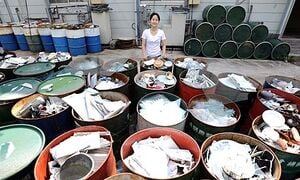
Japan arguably has the best recycling system in the world. This is due to recent laws passed to encourage its citizens and businesses to actively participate in the recycling. In Japan 50% of all solid waste is recycled, in contrast, the U.S. only recycles 30%.
Instigating Legislation[edit | edit source]
60% of Japan's total municipal solid waste is containers and packaging. As a result Japan enacted The Container and Packaging Law. This law is relatively straightforward, it simply promotes efficient use of recycled containers and packages. It accounts for glass containers, paper cartons and all the the different metal substances that beverages and food are sold in. One can think of it as a mandatory recycling program and the result is a 100% beverage can recycling rate.
In April 2001, Japan enacted the Home Appliance Recycling Law. The law as intended to promote the recycling of useful parts of appliances and to reduce the amount of unwanted household appliances in landfills. The law requires that customers pay a recycling fee when disposing of home appliances, that retailers take back the discarded appliances and deliver them to the product to manufacturer, and that the manufacture have an effective recycling process for the item. In many circumstances this law encouraged companies to make their products more recyclable. The law requires that at least 55% of any discarded televisions must be recycled. Companies like Sony used the state mandate as a jumping point. With law providing legal incentive in combination with the cost benefits to using recycled materials, Sony willingly developed televisions that were 86% recyclable.
In Japan, drivers must pay auto manufacturers to recycle old vehicles. The fee is to cover the cost of recycling chlorofluorocarbon, a harmful gas used in air conditioners and airbags and which is a byproduct of automobile shredding. The fee could cost 7,000 to 18,000 yen ($65 to $166 USD). The Automobile Recycling Law enacted in 2005 requires that auto manufactures collect and recycle designated items from end-of-life vehicles, and to improve the recycling rate to 95% from the current 80%. The goal of this law is to encourage auto manufactures to make their cars more recyclable, resulting in more economical products for their customers and to counteract the rising costs of disposing car-related scrap in landfills.
Need[edit | edit source]
Japan is a country with limited onshore resources and a large and growing population. There is little room for waste disposal and landfill sites. Also, due to their industrial economy air pollution is a major factor. So both landfill and incineration are taxing methods for the Japanese to manage their garbage. They are so taxing in fact, that Japan is willing to pay to have much of their solid waste shipped to landfills in other countries. For the Japanese, an efficient recycling system came out of necessity.
Social Impact[edit | edit source]
Recycling in Japan is huge. In Yokohama, Japan there is a total of 10 categories residents are responsible for sorting their garbage into. In Kamikatsu there are 44 categories. It is to the point where cities need to distribute booklets explaining how to sort their trash. Not complying is not an option. Trash is picked up daily and it must be left at a drop off site in transparent plastic bags so it is easy to inspect. An army of volunteers monitor Japan for offending bags. When they find one they will search it for any identifying information so that they can find the owner and encourage him to take better trash handling practices. If problems persist the whistle blower can causes all sorts of misfortune, such as reporting the offense to authorities or landlords. One report mentioned that a young couple was evicted from their apartment due to poor garbage sorting.
References[edit | edit source]
- http://www2.uwstout.edu/content/rs/2007/Recycling.pdf
- http://en.wikipedia.org/wiki/Recycling_in_Japan
- http://www.nytimes.com/2005/05/12/international/asia/12garbage.html
- http://web.archive.org/web/20141114160425/http://everyday.3yen.com:80/category/recycling/
- http://www.toyota-global.com/sustainability/environmental_responsibility/automobile_recycling/responses_to_automobile_recycling_laws_in_japan/responses_to_the_automobile_recycling_law.html